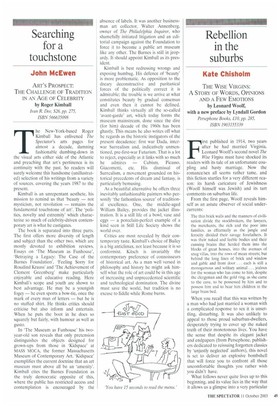Searching for a touchstone
John McEwen
ART'S PROSPECT: THE CHALLENGE OF TRADITION IN AN AGE OF CELEBRITY by Roger Kimball Ivan R. Dee, $26, pp. 275, ISBN 566635098 The New-York-based Roger Kimball has enlivened The Spectator's arts pages for almost a decade, damning fashionable dumbing-down in the visual arts either side of the Atlantic and preaching that art's pertinence is its continuity with the past. So readers will surely welcome this handsome (unillustrated) selection of his writings from a variety of sources, covering the years 1987 to the present.
Kimball is an unrepentant aesthete, his mission to remind us that 'beauty — not mysticism, not revolution — remains the fundamental touchstone of art'. The `politics, novelty and extremity' which characterise so much of celebrity-driven contemporary art is what he castigates.
The book is separated into three parts. The first offers more diversity of length and subject than the other two, which are mostly devoted to exhibition reviews. Essays on 'The Museum as Funhouse', 'Betraying a Legacy: The Case of the Barnes Foundation', 'Feeling Sorry for Rosalind Krauss' and 'The Achievement of Clement Greenberg' make particularly enjoyable and educative reading. Here Kimball's scope and youth are shown to best advantage. He may be a youngish fogey — he even sports a bow-tie, once the mark of every man of letters — but he is no stuffed shirt He thinks critics should criticise but also inform and entertain. When he puts the boot in he does so squarely but fairly, with humour as well as gusto.
In 'The Museum as Funhouse' his twoyear-old son reveals that only pretension distinguishes the objects designed for grown-ups from those in 'Kidspace' at MASS MOCA, the former Massachusetts Museum of Contemporary Art, 'Kidspace' exemplifies the current doctrine that an art museum must above all be an 'amenity'. Kimball cites the Barnes Foundation as the truly democratic opposite of this, where the public has restricted access and contemplation is encouraged by the
absence of labels. It was another businessman art collector, Walter Annenberg, owner of The Philadelphia Inquirer, who shamefully initiated litigation and an editorial campaign against the Foundation to force it to become a public art museum like any other. The Barnes is still in jeopardy. It should appoint Kimball as its president.
Kimball is best redressing wrongs and exposing humbug. His defence of 'beauty' is more problematic. As opposition to the dreary deconstructive and puritanical forces of the politically correct it is admirable; the trouble is we arrive at what constitutes beauty by gradual consensus and even then it cannot be defined. Kimball thinks virtually all the so-called 'avant-garde' art, which today forms the museum mainstream, done since the dire (for him) decade of the 1960s has been ghastly. This means he also writes off what he regards as the historic instigators of the present decadence: first war Dada, interwar Surrealism and, indicatively unmentioned, pre-first-war Futurism. That is a lot to reject, especially as it links with so much he admires — Cubism, Picasso, Giacornetti, etc. His dismissal of Surrealism, a movement grounded on historical precedents of dream and fantasy, is particularly bemusing. As a beautiful alternative he offers three inevitably unfashionable painters who personify 'the fathomless source' of traditional excellence. One, the middle-aged William Bailey, provides the jacket illustration. It is a still life of a bowl, vase and eggs — a porcelain-perfect example of a kind seen in Still Life Society shows the world over.
Critics are most revealed by their contemporary taste. Kimball's choice of Bailey is a big anticlimax, not least because it is so conformist. Kitsch is invariably the contemporary preference of connoisseurs of historical art. As a man well versed in philosophy and history he might ask himself what the role of art could be in this age of increasing and unprecedented scientific and technological domination. The divine must save the world, but tradition is no excuse to fiddle while Rome burns.


















































































 Previous page
Previous page